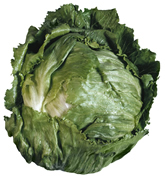This page has been archived and is being provided for reference purposes only. The page is no longer being updated, and therefore, links on the page may be invalid.
Read the magazine story to find out more. |
|
|
Superior Lettuces Fend Off Two Destructive Viruses
By Marcia WoodFebruary 12, 2007
Iceberg lettuce ranks as one of America's top-five favorite veggies. However, this delicately flavored, slightly sweet crisphead and its relatives—the romaine of Caesar salads, the softer textured leaf lettuces, or the creamy butterheads like Boston and bibb—are vulnerable to attack by an impressive array of stealthy viruses and other natural enemies.
But five kinds of superior iceberg lettuces, developed several years ago by Edward J. Ryder of the Agricultural Research Service (ARS), are today still holding their own against attack by two of these daunting villains: big vein virus and lettuce mosaic virus. A world-renowned lettuce breeder, Ryder, now retired, did the work while based at the ARS Crop Improvement and Protection Research Unit in Salinas, Calif.
In 2004, the plants became the first publicly available iceberg lettuces to boast resistance to both diseases. That's why lettuce breeders and seed companies in California and elsewhere were quick to request samples of the tiny black seeds.
Dual-resistance enhances survival because a lettuce field can easily be besieged by both viruses at once. That's according to research horticulturist James D. McCreight, who is in charge of ARS research at Salinas.
Equipping lettuce plants with genes that enable strong, natural resistance is still the most economical, eco-friendly way to defend vulnerable plants from the viral diseases.
Lettuce big vein gets its name from the unhealthy, enlarged appearance of veins in infected lettuce leaves. These lettuces may be bushy-looking or undersized.
The likely culprit? Mirafiori lettuce big vein virus, which makes its way to lettuce roots via a soil-dwelling, funguslike microbe.
Lettuce mosaic, caused by a virus of the same name, results in stunting and unattractive mottling. Green peach aphids can spread the virus as they move about a lettuce field, sipping plant juices.
Read more about the research in the February 2007 issue of Agricultural Research magazine.
ARS is the U.S. Department of Agriculture's chief scientific research agency.


